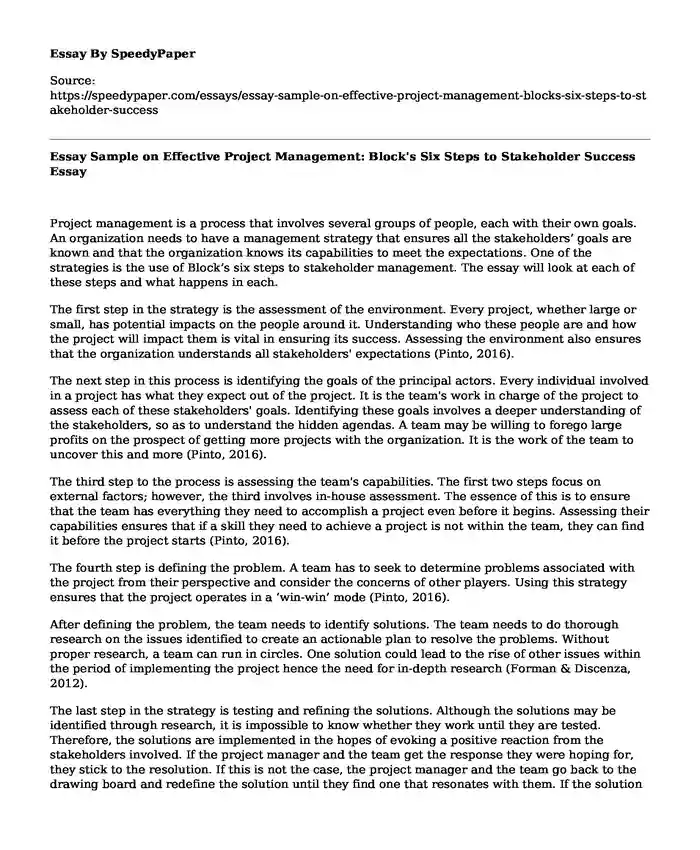
| Type of paper: | Essay |
| Categories: | Project management Company |
| Pages: | 3 |
| Wordcount: | 662 words |
Project management is a process that involves several groups of people, each with their own goals. An organization needs to have a management strategy that ensures all the stakeholders’ goals are known and that the organization knows its capabilities to meet the expectations. One of the strategies is the use of Block’s six steps to stakeholder management. The essay will look at each of these steps and what happens in each.
The first step in the strategy is the assessment of the environment. Every project, whether large or small, has potential impacts on the people around it. Understanding who these people are and how the project will impact them is vital in ensuring its success. Assessing the environment also ensures that the organization understands all stakeholders' expectations (Pinto, 2016).
The next step in this process is identifying the goals of the principal actors. Every individual involved in a project has what they expect out of the project. It is the team's work in charge of the project to assess each of these stakeholders' goals. Identifying these goals involves a deeper understanding of the stakeholders, so as to understand the hidden agendas. A team may be willing to forego large profits on the prospect of getting more projects with the organization. It is the work of the team to uncover this and more (Pinto, 2016).
The third step to the process is assessing the team's capabilities. The first two steps focus on external factors; however, the third involves in-house assessment. The essence of this is to ensure that the team has everything they need to accomplish a project even before it begins. Assessing their capabilities ensures that if a skill they need to achieve a project is not within the team, they can find it before the project starts (Pinto, 2016).
The fourth step is defining the problem. A team has to seek to determine problems associated with the project from their perspective and consider the concerns of other players. Using this strategy ensures that the project operates in a ‘win-win’ mode (Pinto, 2016).
After defining the problem, the team needs to identify solutions. The team needs to do thorough research on the issues identified to create an actionable plan to resolve the problems. Without proper research, a team can run in circles. One solution could lead to the rise of other issues within the period of implementing the project hence the need for in-depth research (Forman & Discenza, 2012).
The last step in the strategy is testing and refining the solutions. Although the solutions may be identified through research, it is impossible to know whether they work until they are tested. Therefore, the solutions are implemented in the hopes of evoking a positive reaction from the stakeholders involved. If the project manager and the team get the response they were hoping for, they stick to the resolution. If this is not the case, the project manager and the team go back to the drawing board and redefine the solution until they find one that resonates with them. If the solution works but has some issues, the team can work to refine the solution. Finally, this step ensures that the team also conducts an accurate self-assessment in the process. It also calls on flexibility in the team as some of these happen mid-course (Forman & Discenza, 2012).
Conclusion
Stakeholder management is a vital component in determining the success of a project. Stakeholders can have both a negative and positive impact on the company. Therefore, organizations must have a good partnership with individuals to have a significant effect on the company. Management strategies like Block’s six steps to stakeholder management have helped stakeholders achieve the company’s goal in time. Success is inevitable when an organization knows its capabilities hence making it easier to meet expectations.
References
Forman, J. B., & Discenza, R. (2012). Got stake: (Holder) management in your project. Project Management Institute.
Pinto, J. K. (2016). Project management: achieving competitive advantage. Pearson.
Cite this page
Essay Sample on Effective Project Management: Block's Six Steps to Stakeholder Success. (2024, Jan 05). Retrieved from https://speedypaper.net/essays/essay-sample-on-effective-project-management-blocks-six-steps-to-stakeholder-success
Request Removal
If you are the original author of this essay and no longer wish to have it published on the SpeedyPaper website, please click below to request its removal:
- Free Paper with Data Analysis Report: Effect of Employee Stress on an Organization
- Free Essay Sample: Customer Relationship Management at Amazon
- Essay Sample on Product Failure Research
- Essay Sample on Decontamination Principles
- Risk Management in Healthcare Organizations - Free Paper Sample
- Benefits of Inclusion - Free Paper Example
- Impact of Finance - Free Paper Example
Popular categories




